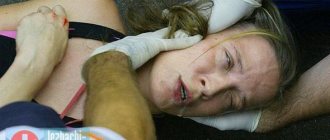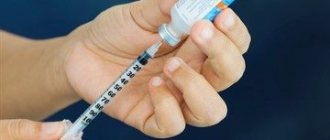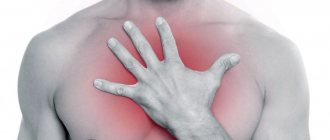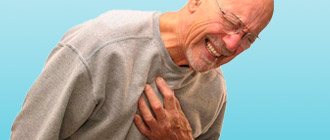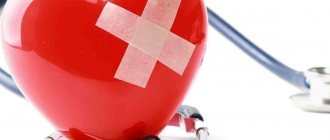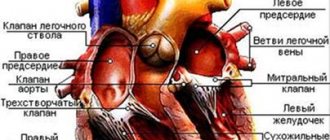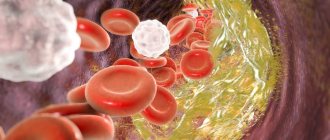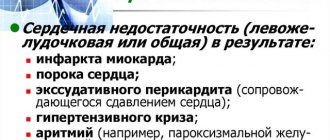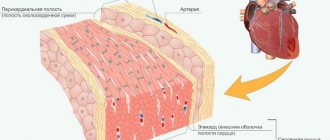- Google+
Restoring the cardiac system is a very difficult issue for anyone who has encountered heart defects and other ailments that are so common in our time. Unfortunately, restoring the heart on your own is practically impossible. It is constantly working, in the case of heart disease, the defect is constantly developing. All that a patient can do in this situation is to try to stop the progression of the disease by strengthening the cardiovascular system. There are a number of drugs for this, which are described below in the article. Under the supervision of a cardiologist, the heart muscle can be restored; for this, all patients with heart disease are required to be treated in hospitals once a year.
There are drugs that can reduce the size of the left ventricle, weaken regurgitation and, in general, greatly help the patient. I will not write about these drugs here, because they have a very dangerous range of side effects, so dangerous that they cannot be used without the direct supervision of a doctor.
Here you can only learn how to improve the condition of the cardiovascular system using simple and safe medications.
Six Simple Must-Have Tips for a Healthy Heart
If you do not have problems with the cardiovascular system, but want to maintain or strengthen it, follow simple rules:
Try to worry and be less nervous. Stress and psycho-emotional tension disrupt blood circulation in the vessels of the myocardium (heart muscle) and can cause the most severe form of coronary artery disease - heart attack, angina pectoris and arrhythmia. Normalize excess weight. Obesity increases the load on the heart muscle, which causes premature loss of its structure and functional abilities. Make sure your blood pressure does not increase. Treat hypertension, as it leads to thickening of the myocardium, aggravates the course of coronary artery disease and provokes a heart attack. Eat right - exclude foods high in cholesterol or consume them in small quantities (animal fats, fried foods, smoked foods, flour), easily digestible sugars and salt. Excess cholesterol is deposited in the walls of the arteries, causing atherosclerosis and narrowing of the lumen, which contributes to obesity. Eat more vegetables, sea fish, vegetable oils and other sources of omega-3 acids, which cleanse blood vessels and strengthen their walls. Balance your physical activity. Both overexertion and physical inactivity negatively affect the condition of the myocardium. Regular physical activity (exercises, fitness, running, gymnastics, dancing, etc.) and a good night's sleep (8 hours) really strengthen the heart. Stop smoking, alcohol abuse, strong coffee and tea.
Do not underestimate the influence of the environment and lifestyle on the condition of the heart muscle. It has been scientifically proven that the more negative factors and the longer they affect the body, the faster pathology will arise. Neither medications nor any other measures will protect you from problems or help strengthen a weakened heart if you do not follow the basic rules. And those who do not have problems with this organ can only with their help maintain health without the use of medications.
Remember - it is impossible to strengthen the heart without normalizing your lifestyle!
Prevention
Preventive measures to prevent hypertensive disease with heart damage:
- Constant control of body weight.
- Drawing up a diet and following it (consuming foods with a low percentage of substances toxic to the body, more vegetables and fruits, fiber, vitamins, minerals, as well as excluding fried and fatty foods from the diet).
- You should stop smoking and alcohol (negatively affects vascular activity).
- Regularly measure your blood pressure at least once a month.
- Do physical exercise every day.
- Enough sleep.
- Control stress.
- If necessary, take sedatives.
All this is required by hypertensive hypertension with predominant damage to the heart.
The best physical activity for suffering patients is moderate walking, swimming, and cycling.
How to restore a heart weakened by disease
Advice from a cardiologist will tell you how you can strengthen your heart. They are especially important for patients who have suffered or have reversible (mild) forms of cardiovascular pathology, in addition to mandatory lifestyle correction measures:
See a specialist - a cardiologist or therapist. Periodically (at least once a year) examine the cardiovascular system: ECG, ECHO (ultrasound) of the heart, general blood and urine tests, control over sugar levels, lipid levels and blood clotting. If there are abnormal tests or symptoms indicating progression of the disease, increase the frequency of examinations and visits to the doctor. Treat not only cardiology, but also any other pathology in the body (for example, lung disease, liver disease, etc.). Any chronic processes negatively affect the condition of the myocardium. Take only medications prescribed by a doctor, since uncontrolled use of medications that have a toxic effect on the myocardium can cause organ damage or aggravate the course of an existing pathology.
Drug support of the myocardium
It is impossible to strengthen a diseased heart without the use of medications. This requires drugs that directly restore the functional abilities of the myocardium - cardioprotectors. Their therapeutic effect occurs gradually, which requires long-term and systematic use (at least 1 month, 1-2 times a year). The most effective and often prescribed cardioprotective drugs that strengthen the heart muscle are:
| Vitamins and microelements | Milgamma Vitrum Cardio Magne B6 Vitamin E Asparkam (Panangin) |
| Herbal remedies | Kratal Tincture of lily of the valley or hawthorn |
| Synthetic cardiotonics | Preductal |
Injectable drugs (shots) are more effective - they act faster and stronger than tablets and other forms for internal use. Therefore, it is most advisable to use a stepwise treatment regimen - first administer medications in the form of injections (intravenously or intramuscularly), and then maintain their dose with tablets. Depending on the condition of the heart, you can use either only one drug or combine 2-3 cardioprotectors from different groups.
How to quickly lower cholesterol at home?
How to restore heart rhythm yourself
The heart is one of the most delicate and sensitive organs in our body. Disturbance of normal heart rhythm, in other words, arrhythmia, depends on many factors, the main one among them is: the individual sensitivity of each person and his nervous system.
And also, it can be a symptom of serious heart diseases, such as heart failure, heart disease, myocarditis and others. Useful tips that answer the question: how to restore heart rhythm?
Normalizing the work of the heart, the rhythm of its work, and forgetting about chest pain forever is probably the dream of every person who has a chest pain. We will give you a few rules that will help you with this.
1. Reviewing our diet. Yes, this is one of the important factors that influence the functioning of your heart. We exclude from the diet: very high-calorie and fatty foods, foods with a huge amount of artificial fillers and additives, coffee and strong tea, and reduce the consumption of sweet foods.
2. Get rid of bad habits: smoking, drinking alcohol. 3. We avoid physical overload of the body and emotional stress.
5. We drink delicious peppermint tea. Pour 1 teaspoon of chopped mint leaves into one glass of boiling water. Leave for one hour in a warm place. We drink the infusion half an hour before breakfast.
6. Drink herbal infusion. Bring one glass of water to a boil. Separately mix hawthorn fruits, chamomile and motherwort. Throw 1 tablespoon of the herbal mixture into boiling water, cook for a few minutes, and leave for about an hour. We take the herbal infusion 3 times a day.
7. If you suffer from a slow heartbeat, then walnuts, lemons and sesame oil are perfect for you. From these ingredients we make a very tasty medicine. Wash the lemons and cut them into several pieces.
In a saucepan, bring 100 ml of water to a boil, put the lemons in boiling water and cook on the fire for about 7-8 minutes. Then cool and grind. Add 250 grams of chopped walnuts, 100 grams of powdered sugar and 125 ml of sesame oil.
8. If you have a rapid heartbeat, then there is another medicine for you. We make a herbal mixture from the following components: motherwort herb, valerian roots, anise fruits and yarrow herb. Mix all the herbs well, take 1 tablespoon of this collection, pour a glass of boiling water and leave for about one hour and only in a warm place. Then we filter and take about a gram 2-3 times a day before meals.
9. Take a glass jar, only a dark one, and mix the tincture of Corvalol, valerian, hawthorn and motherwort. Mix and take drops 3 times a day half an hour before meals.
DETAILS: Ultrasound of the heart during pregnancy, characteristics and indications for examination
10. Heather tea (stems with flowers). It improves the functioning of your heart, calms the nervous system, and relieves spasms. Pour 1 tablespoon of chopped dry herb into two glasses of boiling water, keep on low heat for about 15 minutes, leave for two hours.
We drink it throughout the day like regular tea. Folk remedies are of course very good, but remember, sometimes self-medication can do you more harm than good. Your heart hurts, its rhythm is unstable, traditional methods do not help, do not hesitate, contact a cardiologist.
- Right carotid artery pressure;
- Pressure on the eyes with your fingers (several minutes);
- Straining while inhaling (take a deep breath and strain);
- Inducing a gag reflex;
- Strong flexion of the torso;
- Tightening the limbs with a tourniquet (not for the elderly).
The vagal reflex is also triggered by immersing the face in very cold water for a few seconds.
Mix and store in a tightly closed container. During an attack, apply 5 drops to a clean cotton cloth and inhale alternately into each nasal passage.
Mix, take during an attack, dissolving 20 ml of solution in a glass of water. Drink in small sips.
Restoring a damaged heart in heart failure
The most difficult thing to strengthen is the heart, which has irreversible changes. In severe acute and chronic diseases (myocarditis, cardiosclerosis, coronary disease, cardiopathy, heart attack), it loses its ability to pump blood. Therefore, in addition to lifestyle correction and taking cardioprotectors, the following is necessary:
| Cardiac glycosides – a pronounced strengthening effect on the myocardium | Celanide |
| Diuretics - do not strengthen the heart, but reduce the amount of fluid in the body, which reduces the load on it | Lasix |
| ACE inhibitors – with long-term use, they slow down the replacement of the myocardium with scar tissue, restore cell structure, and lower pressure in blood vessels | Enalapril |
| Blood thinners – improve blood supply to the myocardium | Clopidogrel Aspirin Cardio |
None of the drugs should be taken without prescription and supervision by a doctor!
Treatment of the disease
After diagnosing the disease, the doctor develops a treatment plan, which involves stabilizing blood pressure and normalizing heart function. As part of therapy, the specialist prescribes medications with the following spectrum of action:
- diuretics (diuretics);
- antihypertensive drugs;
- blockers that have a hypotensive effect and reduce the amount of oxygen used by the heart;
- blood thinners (aspirin).
As a complement to drug therapy, the patient is required to follow a therapeutic diet that reduces cardiac workload:
- reducing the amount of salt consumed;
- fats of animal origin are replaced by vegetable ones;
- fatty varieties of meat are excluded - dietary types are consumed;
- preserved foods, marinades, and spicy dishes are confiscated;
- stop drinking alcoholic beverages.
In addition to the above, the patient is required to quit smoking.
4.1 Preventive measures
Preventive measures are based on the implementation of several rules:
- Monitor body weight and blood pressure levels at least once a month.
- Changing your diet - eat more vegetables, fruits, and fiber-containing foods. Reduce the amount of spicy and fatty foods.
- Follow a healthy lifestyle, stop smoking and drinking alcoholic beverages.
- Normalize sleep/wake patterns.
- Avoid stressful situations or take sedatives (as prescribed by your doctor).
Traditional methods of preventing arterial hypertension are also effective:
- chamomile infusion;
- mint and lemon balm;
- valerian;
- rosehip infusion or tea.
However, before using them, consultation with a treating specialist is required.
What effect can you expect - forecast
Activities aimed at strengthening the heart should be individually selected depending on the person’s condition and the category of health of the cardiovascular system. The table describes these categories and indicates how well the organ can be strengthened by following the appropriate recommendations.
| People who do not have cardiac diseases, but want to maintain a healthy heart and blood vessels | High – more than 95% |
| Patients with mild forms of cardiac pathology without signs of heart failure | Average – 70–80% |
| Patients with severe cardiac pathology and heart failure | Low – no more than 50% |
Measures to strengthen the heart in the first group are minimal, but the most effective and relevant for all categories of patients. The second group must adhere not only to these, but also additional recommendations, although the ability to achieve an effect is still lower than that of people in the first group. For the third category of people, activities should be even more expanded than for category 2, but the opportunity to strengthen the heart is the lowest.
Rate this article:
(1 votes, average rating: 5.00)
In modern society, cases of heart attacks and strokes are increasingly being recorded, and these diseases have become much younger. Therefore, the question of how to strengthen the cardiovascular system remains very relevant.
Rules to follow
In order for a healthy person to never have problems with the heart and blood vessels, certain rules should be followed to help prevent serious diseases.
Nutrition and weight
Watch your diet. For normal heart function, it is necessary that the food be rich in vitamins and essential microelements. Proteins, fats and carbohydrates must be carefully balanced in the diet. The total daily amount of food should be divided into portions and taken, if possible, from 3 to 5 times a day.
You should limit your consumption of the following foods as much as possible:
fatty meat, as well as liver and kidneys; margarine, fatty milks, sour cream, cheese; all high-fat baked goods; semi-finished products, fast foods, canned foods; completely eliminate alcohol, strong tea, coffee, cigarettes.
The use of the following products is beneficial for normal heart function:
white poultry, veal; low-fat dairy products; any types of fish, especially fatty sea fish; any fresh berries, fruits and vegetables; unprocessed cereals (oatmeal, buckwheat, pearl barley, rice); yeast-free bread, nuts, oatmeal cookies; any fresh herbs.
If you adhere to such recommendations throughout your life, you can prevent problems with the cardiovascular system.
Our readers recommend
To prevent diseases and treat the manifestations of varicose veins on the legs, our readers recommend the NOVARIKOZ spray, which is filled with plant extracts and oils, therefore it cannot harm health and has practically no contraindications. Doctors' opinion...
These nutritional rules will also help you reduce excess weight, even if you do not adhere to special strict diets, which is also important for the prevention of hypertension, acute and chronic circulatory disorders in the heart and brain.
Watch your spine
Strengthening the cardiovascular system also implies the normal passage of impulses from the central nervous system.
Regulation and control of the work of all organs is carried out in the central nervous system. For example, with osteochondrosis or other problems in the cervical spine, coronary blood flow is disrupted, which makes it difficult to supply the heart muscle with oxygen.
Often, pinching of the nerve endings between the vertebrae leads to increased heart rate and leads to increased pressure, which increases the load on the heart and the myocardial oxygen demand; with concomitant changes in the coronary vessels, myocardial ischemia can occur.
Physical exercise, a combination of sedentary work with sports, walks in nature, running, and swimming help to avoid such situations.
Timely consultation with a doctor regarding problems with the spine and initiation of treatment will help to avoid many problems associated with other organs and systems, including blood vessels and the heart.
Physical exercise
In addition to improving the condition of the spinal column, moderate physical activity helps strengthen the cardiovascular system and significantly increase its efficiency.
For this purpose, there are special aerobic exercises, they are also called cardio training. These aerobic exercises are aimed at strengthening the heart muscle, lungs and blood vessels, aimed at stabilizing blood pressure, increasing metabolic processes and reducing body weight.
Each person can choose for themselves the most optimal load and activity according to their preference. Outdoor activities may include skating, skiing, running, race walking and swimming. In the gym you can choose an exercise bike, jump rope, or treadmill.
The point of such training is to increase oxygen consumption and increase heart rate within normal limits, and many muscle groups are necessarily involved in the process.
The duration of exercise should be adjusted according to age and body capabilities. The most important thing is to practice regularly. If you have chronic diseases, you should consult your doctor before exercising. This is especially true for people who have led a sedentary lifestyle for a long time and people who are overweight. For this category, classes should begin with a minimum load and gradually increase it over time.
Signs of cardiac recovery
⇐ PreviousPage 7 of 9Next ⇒The appearance of an independent pulse in the carotid or radial arteries, a decrease in pallor or cyanosis of the skin.
If signs of heart activity appear, the massage is stopped, but you must be prepared to resume it - repeated cardiac arrests are not uncommon.
Timing and combination of resuscitation techniques
The success of resuscitation is largely determined by the time, start and quality of cardiac massage and artificial respiration, as well as their rational combination.
If two people provide assistance, then one of them performs cardiac massage, and the other performs artificial respiration. In this case, blowing into the victim’s mouth or nose
make every four pushes on his sternum (Fig. 30).
In cases where assistance is provided by one person, which is extremely difficult, then the sequence of manipulations and their regime change - after every two quick injections of air into the victim’s lungs, 10-12 chest compressions are performed with an interval of 1 second.
Rice. 30. Simultaneous artificial respiration using the mouth-to-nose method and closed cardiac massage
If cardiac activity remains (the pulse is felt, the heartbeat is heard), artificial respiration is carried out until spontaneous breathing is restored. In the absence of heartbeats, artificial respiration and cardiac massage are carried out for 60-90 minutes. If during this period spontaneous breathing does not appear and cardiac activity does not resume, resuscitation is stopped.
Cardiac massage and artificial respiration must be carried out until obvious signs of biological death appear. One of the first signs is clouding of the cornea and drying out. When you squeeze the sides of the eye with your fingers, the pupil narrows and resembles a cat's eye.
Loss of consciousness
Not a single injury or illness of a tourist during hiking conditions causes such confusion, unnecessary and dangerous actions on the part of others as the sudden loss of consciousness of the victim. Any stage or form of loss of consciousness is indeed a very serious symptom of a life-threatening injury or condition. Loss of consciousness itself, regardless of the reasons for its development, can lead to early death in the absence of emergency assistance. At the same time, simple, calm and purposeful actions of the group often save the life of such a victim.
Causes. We present the reasons for the development of the unconscious state in descending order of frequency. Most often, loss of consciousness develops with trauma to the skull and brain, with severe injuries to the skeleton and internal organs, which occurs when falling from a great height, or with injuries during a rockfall. Unconsciousness can occur due to drowning or being caught in an avalanche. The main danger in such conditions is asphyxia (suffocation), lack of oxygen and, as a reaction to this, loss of consciousness. In third place in frequency is lightning, severe forms of heat or sunstroke. Loss of consciousness may be accompanied by severe forms of poisoning and infectious diseases
when there is a delay in medical assistance, that is, in advanced stages. And finally, after convulsions during an epileptic seizure, an unconscious state often remains for several hours, which in such cases smoothly turns into sleep (but the person can already be woken up). Consciousness is lost during fainting and collapse, but most often for a few seconds (up to a minute). If consciousness is not quickly restored, you should think about other reasons for its loss.
Symptoms . It must be remembered that loss of consciousness can be of varying depths or go through several stages - from the mildest to the critical. It is important to know this in order to be able to recognize the onset of a dangerous condition early and organize quick help without waiting for the development of a later, difficult-to-treat stage.
A slight loss of consciousness (a blow to the head, a fall from a small height, overheating, poisoning) is expressed in a state of stunning. The victim seems to withdraw into himself, but verbal contact with him is preserved: you need to repeat the question several times, persistently and loudly, in order to receive a slow, quiet, monosyllabic (“yes”, “no”), sometimes indistinct answer. The victim does not understand or slowly follows the simplest instructions; when asked about the presence of pain, he often gives a negative answer. However, when carefully palpating, checking movements in the joints in the presence of fractures or other injuries, he reacts to pain with a protective facial reaction.
With further deepening of the disorder of consciousness, a so-called soporous state occurs: severe drowsiness, complete apathy, immobility. At the loud call, the victim only opens his eyes, his gaze indifferent. Reacts to pain with a groan or a facial grimace.
Deep loss of consciousness - coma: complete lack of reaction to external stimuli, including pain, a state that sometimes resembles sleep, but it is not possible to wake up such a person. At this stage, critical respiratory and cardiac disorders often develop (see resuscitation techniques).
You need to especially carefully monitor the mental state of the victim in cases where you were not eyewitnesses to the injury. In such circumstances, one must always remember about the possibility of brain injury, so early diagnosis - even at the beginning of the development of loss of consciousness (in the stage of mild stunning) - is of life-saving importance.
Urgent Care
Emergency care consists of two measures: firstly, urgently calling a doctor, and if this is not possible, transporting the victim to an ambulance or ambulance helicopter (plane), and secondly, preventing possible complications.
With a slight loss of consciousness (stunning, stuporous state), vomiting often occurs, and if the victim lies on his back, then there is a danger of vomit getting into the respiratory tract and the rapid development of suffocation (asphyxia).
In a comatose state, paralysis of the muscles of the esophagus and the entrance to the stomach occurs, and passive leakage of stomach contents into the oral cavity occurs. As a result, as with vomiting, gastric contents enter the respiratory tract and lungs with each breath, which also leads to asphyxia.
In such a difficult situation, cardiac and respiratory arrest may occur quickly, sometimes within a matter of seconds. The use of closed heart massage and artificial respiration is useless, because the airways remain impassable for air. That is why, in case of loss of consciousness, the prevention of asphyxia is invaluable. For this purpose, the unconscious victim is given a so-called stable or fixed position. The position is called stable because the victim, even when transported on a stretcher, cannot turn onto his back or stomach.
The rules for placing the victim in a lateral position are as follows. Two people (at least) come up to him, lying on his back, and kneel on his left and one on his right. Those standing on the left carefully place their right hands under the pelvis and under the shoulder blades of the person lying down. Helping with your left hands, gently turn the victim onto his right side. The one standing on the right at this time simultaneously turns his head with both hands. Then, to impart stability in this position, the left, that is, “upper” leg is bent at a right angle at the hip and knee joints, as shown in Fig. 31. The victim’s right arm remains lying along the body, behind the back, and his left arm is bent at the elbow and placed under the head, with the palm facing down. In other words, the victim does not lie strictly on his side, but slightly tilted forward. Thus, support in this pose occurs at several points: on the right half of the pelvis and thigh, left joint, left shin and foot, left elbow and head.
It is necessary to ensure that the victim’s free breathing is not interfered with by a hand or other objects placed under the head. In addition, his face should remain open to monitor breathing and to cleanse the oral cavity if gastric contents flow into it. The victim must remain in this position throughout the unconscious state. Constant monitoring of freedom of breathing, pulse, and skin color is required. If cardiac or respiratory arrest occurs, the victim is gently turned onto his back using the same techniques, a cushion is placed under the neck, and resuscitation techniques begin (see p. 124).
During transportation (especially over rough, mountainous terrain), the victim, lying in a lateral position, is additionally not tightly secured to the stretcher with wide belts or some kind of cloth in the form of scarves. They are tied in the pelvis, shoulder joints and legs. The restraints should not restrict breathing.
If there is the slightest suspicion of a fracture of the pelvis, spine, bones of the upper or lower extremities (if a fall from a great height, hit by a large stone), it is impossible to give the lateral position due to the danger of displacement of the fragments. In such cases, the victim is placed on his back with a bolster under his neck and his head slightly thrown back for freedom of breathing.
| Bandages. Immobilization. Transportation of the victim |
| Bandages |
Depending on the purpose of use, dressings are divided into cover dressings, which serve to hold a sterile napkin lying on the wound, pressure ones, to stop bleeding, and immobilizing ones, which serve to achieve immobility of the wounded area. Cover bandages are the most widely used.
The bandage must be applied firmly, it should not slip, but at the same time not press too hard, causing pain and impairing blood circulation. The wounded person must sit or lie down during dressing; The part of the body to be bandaged must be exposed and easily accessible for applying a bandage.
Bandaging methods. Bandaging is done by applying bandage moves, with each subsequent move half overlapping the previous one. The wraps of the bandage are applied in the form of a spiral - serpentine; in the form of a figure eight - for example, crossing when bandaging an elbow, knee - and spica-shaped. After bandaging is completed, the end of the bandage is torn lengthwise into two halves and each end covers the part of the body to be bandaged, after which the ends are loosely tied.
Sometimes you have to apply an improvised bandage - a clean handkerchief, scarf, towel or torn pieces of linen.
Bandages for injuries to the head (Fig. 32), face (Fig. 32), and neck. They should not bunch up or put pressure on sensitive areas such as the ears and forehead, as well as the neck or chin. If the nature of the injury allows, bandages should not cover the eyes and ears. A bandage made of bandages and cotton wool for immobilization of the cervical vertebrae is shown in Fig. 33.
Bandages on the chest (Fig. 34), abdomen and pelvis (Fig. 35). For bandaging the chest, it is better to use wider bandages. If the bandage is applied incorrectly, it will slip off.
Bandages are applied to the abdomen and pelvis in the usual spiral manner, since in this area of the body they are held more firmly than on the chest. The first moves are applied in the upper part of the abdomen, gradually moving to its lower part. The last moves are applied to the right thigh, where the bandage ends.
Rice. 32. Types of bandages for injuries to the head and face: a - sling-shaped bandage on the nose; b - bandage on the lower lip and chin; c — bandage on the chin; d — bandage from a headscarf on the occipital region; e, f - stages of applying a bandage to the scalp; g - bandage on the left eye; h — bandage on both eyes; c - bandage on the occipital region (numbers indicate the order in which the bandages are applied, and the arrows indicate their direction).
Rice. 33
Bandage made of cotton wool and bandages for damage to the cervical vertebrae.
Spica-shaped or figure-of-eight bandages are applied to the area of the hip joint, pelvis and perineum (Fig. 35, c, d, e).
Bandages of the upper and lower limbs . The first moves should be applied to the lower part of the limb, and then the bandaging is carried out in an upward direction. This method of dressing allows you to avoid the accumulation of venous blood in the free, unbandaged parts of the limbs.
A spica bandage is usually applied to the shoulder joint and lower leg (Fig. 36); a figure-of-eight bandage on the elbow joint (Fig. 37d). The same type of bandage is applied to the knee joint. If the shoulder joint, humerus or elbow joint is damaged, a Deso bandage is used (Fig. 31.6).
When applying bandages to the fingers of the hand, the palmar surface of the hand, and the area of the wrist joint, different types of bandaging are used (Fig. 38).
Various bandages are applied to the foot and ankle joint (Fig. 39, 40).
Types of scarves are shown in Fig. 41.42.
The diagram for using a tubular bandage is shown in Fig. 43.
| Immobilization using improvised means |
When traveling to areas remote from populated areas, situations may arise when emergency transportation and immobilization (immobilization) of an injured or sick person must be carried out using the equipment available to the tourist group (ropes, cords, skis, backpacks, etc.) , as well as using natural materials (poles, tree branches, bushes, etc.).
Rice. 34. Bandages for chest injuries: a - spiral bandage with one armhole; b - spiral bandage with two armholes; c, d - bandage for unilateral chest injury
Rice. 35. Bandages for injuries to the abdomen and pelvis: a, b - stages of applying a bandage to the abdomen; c - on the hip joint and thigh; Mr. pelvic area; d - on the perineum
Rice. 36. Spica bandages: a - on the foot and lower leg; b - on the shoulder joint
Rice. 37. Bandages for damaged joints of the upper limb: a - figure-of-eight bandage on the elbow joint; b — Deso bandage
Rice. 38. Bandages for injuries to the fingers and hand: a - recurrent; b - spiral; c - spicate; d - on all fingers of the hand (“glove”); d — spica bandage on the hand
Methods of transportation and immobilization using improvised means can be very diverse depending on the equipment and the terrain. However, in all cases, certain rules must be followed to ensure reliable immobilization and safe transportation for the victim.
Rice. 39. Bandages for injuries to the foot and ankle joint: a - recurrent; b - spicate; c - eight-shaped; g - on the heel area
Rice. 40. Adhesive paste immobilization for injury to the big toe
Rice. 41. Scarf bandages for injuries: a - head; b—brushes; c - area of the elbow joint; g - shins; d - gluteal region and upper thigh; e - both buttocks; g - feet; h - heel area
Rice. 42. Figure-of-eight bandage for a clavicle fracture
Rice. 43. Scheme for using a tubular bandage
Immobilization for all injuries accompanied by bone fractures, extensive wounds and burns. The main goal of immobilization is to ensure as complete rest as possible for the injured part of the body, which eliminates additional trauma and reduces pain. If necessary, use special immobilizing devices - splints, scarves. Improvised means are used as tires - sticks, branches, skis, oars, boards, etc. (see Fig. 44, 45). The immobilizer should be strong and as light as possible.
Methods for immobilizing and carrying a victim for injuries of various locations are given in Table 5.
Rice. 44. Immobilization with improvised means for a spinal fracture: a — top view; b - rear view
Rice. 45. Immobilization with improvised means for a fracture of the femur
Table 5
Methods of immobilization and transfer of a victim for injuries of various locations.
| Location of injury | Immobilization method | Position of the victim during transportation | Carrying method |
| Head, neck | Place sandbags or bundles of soft clothing on the sides of the head, fixed to the stretcher | On the back; in the absence of consciousness - lying on your side | Standard or improvised stretcher |
| Breast | No need | Semi-seated | Standard or improvised stretcher with a pad of clothing under the upper body Standard or improvised stretcher |
| Stomach | No need | Lying or sitting, depending on the condition of the victim and terrain conditions; cold on the stomach; roll of clothing under the knees | Standard or improvised stretcher |
| Pelvis | The legs are connected to each other; place a bundle of clothes under your knees | On the back | Standard or improvised stretcher |
| Spine | No need | On the back or stomach | Standard or improvised stretchers; when carried on the back, a rigid (wooden) shield is required; when carried on the stomach, a cushion of clothing under the chest |
| Shoulder | Fix the wrist, elbow and shoulder joints. Place the splint on the back surface of the forearm and shoulder, on the arm bent at an angle of 90° at the elbow joint from the fingers to the opposite forearm. If there is no splint, place your hand in a scarf and secure it to the body with a second scarf. | The position is free; for general weakness - sitting or lying down | Independent forward; movement; for general weakness - sitting on the arms or straps of carriers |
| Forearm | Apply the splint from the fingers along the back surface of the arm, bent at an angle of 90°, and secure with a bandage or scarf | Same | Same |
| Brush | Apply the splint along the palmar surface of the hand and forearm from the fingertips to the elbow joint; place a small soft cushion under your fingers | Independent movement | |
| Hip | Fix with three splints: 1st - along the plantar surface of the foot, the back of the shin and thigh; 2nd - along the inner surface of the foot, lower leg and thigh; 3rd - along the outer surface of the lower limb and torso from the foot to the armpit. Legs tied together | On the back | Standard or improvised stretcher |
| Shin | Apply two splints (front and back) from the upper third of the thigh to the heel | Sitting, with general weakness - lying down | Lying - on a standard or improvised stretcher, sitting - on the hands or straps of porters |
| Foot | Apply a splint along the plantar surface of the foot and the back of the lower leg from the tips of the toes to the upper third of the lower leg; the foot to the shin should be at an angle of 90° | Position is free | Independent movement with the help of improvised crutches; sitting - on the hands or straps of porters |
| Methods of transporting and carrying victims |
The method of transporting and carrying the victim depends on the nature and location of the injury, his general condition, as well as the number of people providing assistance and their physical capabilities. Depending on the specific conditions, victims can be carried on an improvised stretcher, on hands (Fig. 46) using stretcher straps made from a piece of tarpaulin 2 m long and up to 10 cm wide (Fig. 47), etc.
“Gazebo” for lowering the victim without an accompanying person (Fig. 48). If the victim has a chest harness, then a loop is made from a 3.5-4 meter cord that is placed behind his back. The upper end wraps around the back, the lower end around the hips. Then the upper end on both sides of the body is brought forward, the lower end is pulled forward and upward between the legs and connected with a carabiner attached to the main (descent) rope. To avoid tipping over during the descent, a cord runs from the victim’s chest harness to the main rope, tied on it with a gripping knot at a distance of no more than 10-15 cm from the chest.
If the victim does not have a chest harness, preparation for descent is carried out as follows. His chest is covered twice with a 4-meter cord, after which a bowline knot is tied in front. The longest of the remaining ends of the cord is thrown over the left shoulder, threaded under the harness and returned over the right shoulder, where it is tied either with a bowline or a straight knot to the other, short end.
Rice. 46. Hand position when carrying a victim with limb injuries
Rice. 47. Carrying a victim using stretcher straps: a - position of the straps on the victim; b, c - methods of carrying.
The second 4-meter cord is made into a “gazebo”; the cord is placed on the hips and crossed in front, then from behind between the legs it is pulled forward and upward and, together with the crossed ends, taken into a carabiner, and the remaining ends are raised obliquely upward, wrapped back - around the lower back - and tied "Bowline" in front. The figure-eight cord covers the hips and lower back and creates a comfortable seat.
“Gazebo” at the ends of the main rope with two loops for lowering the victim and the accompanying person (Fig. 49). Required: 2.5 m of rope and lanyard.
Rice. 48. “Gazebo” and chest harness for lowering the victim without an accompanying person
Rice. 49. “Gazebo” for the descent of the victim with an accompanying person
Rice. 50. “Gazebo” with three loops for lowering the victim
A double “conductor knot” is tied at the end of the rope, both loops of which are placed on the victim’s hips. The length of the loops should not exceed 40-50 cm. A grasping knot is tied with a cord on the main rope - slightly above the level of the victim’s chest, and the remaining ends are tied around his chest (or the cord is snapped with a carabiner to the chest harness). This eliminates the possibility of tipping over.
“Arbor” at the ends of the main rope with three loops (Fig. 50). Required: main rope and ice ax (stick).
The end of the main rope is folded into four loops of 1.5 m each. A little above the middle of the folded loops, all four ends are tied with a “conductor knot”, forming three loops - two large for the seat and one smaller (adjustable), which is put on the victim over the shoulder and chest. For convenience, an ice ax or stick is threaded through the seat loop.
On a backpack with a stick. (Fig. 51a). Required: backpack, stick(s) or ice ax.
A stick about 1 m long (can be a ski pole) is threaded through the straps of an empty backpack and the backpack is put on the back. The victim sits on a stick, hugging the shoulders of the person providing assistance. To prevent the victim from tipping over, the two ends of the cord coming from his chest harness are fastened in front to the carrier’s chest harness. To reduce the pressure of the stick on the victim’s hips and the back of the bearer, it should be wrapped in something soft (storm boots, sweater, etc.).
In the backpack (Fig. 51.6). You need to open the side seams of the backpack about 30 cm from the bottom. Having passed the victim’s legs through these holes, the backpack is put on him like trousers and tied at chest level. Carrying is carried out by one person.
On a rope (Fig. 51, c, d). The loops of the wound rope (20-30 m) are divided into two equal parts, into which the victim sits. To avoid tipping over while being carried, the victim is tied with a chest harness or a cord to the carrier.
Rice. 51. Carrying the victim: a - on a backpack with a stick; b - in a backpack; c, d - on a rope
Carrying by two people on cross sticks (Fig. 52, d). Required: two backpacks, a strong pole 1.2-1.4 m long or two tied ski poles.
Rice. 52. Carrying the victim together: a - on cross sticks; b, c - on poles or skis with storm boots
If the terrain allows, those providing assistance should walk nearby. A stick or ski poles wrapped in something soft are threaded through the straps of backpacks worn on the backs. The victim sits on a stick and places his hands on the shoulders of those carrying them to maintain balance.
Carrying by two people on poles (or skis) with storm boots (Fig. 52, b, c). Required: two backpacks, two poles of at least 2.1 m or skis of the same length, three or four windbreakers.
Poles or skis are threaded through the sleeves of the windbreakers, and the windbreakers are fastened over the poles. The ends of the poles are threaded into the straps of backpacks worn on the backs of those providing assistance. The victim is placed on the stretcher with his head in the direction of travel. The backpack of the person in front serves as a headboard, so a sleeping bag or something soft is placed in it.
This type of carrying is equally convenient for the lying and semi-sitting position of the victim. When transporting in winter, it should be dressed warmly and placed in a sleeping bag.
Carrying on a braided rope stretcher. To the left and right of the middle of the main or auxiliary rope (30 m), two “conductor knots” are knitted so that the distance between them when the rope is taut does not exceed 50-55 cm. Three loops are made on both halves of the rope at a distance of 50 cm, three - at a distance of 80 cm and three - at a distance of 90 cm. The loops must be knitted so that a fist can easily pass through them. The resulting loops of each half are placed crosswise so that they are on both sides of the outside of the resulting mesh. If the loops are tied at the correct distance, there will be about one and a half meters of free space at each end of the rope.
The victim, wrapped in a sleeping bag or tent, is placed on a net, and the accompanying persons, holding one or more loops, carry him.
Since this method of transportation is quite labor-intensive, it can be greatly simplified by threading poles, ski poles, and tied ice axes through the loops (while the mesh is on the ground), using the mesh as a stretcher.
There is another way of carrying it on a stretcher made of braided ropes. At a distance of 20-25 cm from the middle of the rope, loops measuring 38-40 cm are knitted. Then, 1 m from them in both directions, a second loop is knitted and after another 1 m - a third loop, after which the remaining ends of the rope are tied together and a mesh is woven (Fig. 53 ). The stretcher obtained in this way can carry six tourists, but if the poles are threaded through the loops, then two people are enough to carry it.
Rice. 53. Rope net for carrying the victim
Rice. 54. Carrying the victim on a stretcher-basket
Rice. 55. Lowering the victim using a pole
Carrying on a stretcher-basket (Fig. 54). Required: main rope or cord - 30 m, ice ax (stick), three carabiners.
Rice. 56. Carrying a victim on an improvised stretcher using a pole
A small “conductor knot” is knitted at the end of the rope (this is the lower end of the stretcher - the “legs”). Then the rope is laid with a snake widening upward; The length of the convolutions is determined depending on the volume of the victim’s body, and the number is determined depending on his height. To improve the position of the victim when carrying, coils should be applied as often as possible.
The victim must be wrapped in a sleeping bag or tent, placed on turns of rope, and the stretcher must be “laced up” starting from the feet.
Depending on the upcoming transportation (carrying along a slope or descending vertically), a pole is tied to the stretcher, or it is fastened to a descent rope. In the latter case, a spacer is first made between the ropes running from the legs and head to the descent rope (Fig. 55).
Carrying on a pole (Fig. 56). Required: a pole at least 3 m long, a transport bag or stretcher made of ropes, a stick 60-70 cm long or an ice ax.
The bag or stretcher is tied to the pole so that the handle remains: for the one walking in front - 45-50 cm long, for the one walking behind - at least 65-70 cm. For ease of transportation and to avoid swinging of the victim, the bag is tied to the pole as close as possible. At the level of the victim's chest, a crossbar is attached to the pole - a spacer, with the help of which the edges of the bag or stretcher are held in an extended position. In the area of the middle of the body around the transport bag, a sleeping bag liner, harness, etc. are attached to the pole.
Stretcher made of poles (Fig. 57, a). Required: two poles 2.5-2.6 m long, five poles 50-60 cm long (or ice axes), cord - 30 m.
The poles are laid parallel at a distance of 55-60 cm from each other and connected at the head by two crossbars - one on top and closer to the edge, the other below, 10-15 cm from the first.
In the lower part (“legs”) the poles are fastened with one crossbar. The remaining two sticks are used to make a headboard: they are inserted from above between the crossbars of the head part and tied to them in such a way as to form a triangle. All rope fastenings on the stretcher are made into knots with strong tightening and markings.
The surface of the stretcher is braided with a cord, and the mesh should be thick and tightly stretched, with the exception of the headboard, where some sagging creates a more comfortable position for the victim’s head.
Dragging stretchers made of poles (Fig. 57.6). Required: two flexible poles of equal thickness, 4-5 m long; three crossbars of 60-65 cm, two strong and flexible poles of at least 2 m each, with branches left at the ends, a cord - 30 m and three cords of 4-5 m.
The poles are laid parallel and fastened with two crossbars at a distance of 1.8-2 m (depending on the height of the victim), and the first crossbar is attached 40-50 cm from the head of the poles, after which a mesh for the bed is woven from the cord. Then, 25-30 cm from the second crossbar, another crossbar is attached to the poles below. Between these two crossbars, poles are inserted from below, slightly apart to the sides, and secured at four points. Long poles together with poles spring during transportation and protect the victim from shocks when passing uneven surfaces.
If transportation is carried out by one person, the victim is placed on a stretcher with his feet in the direction of movement, if by two, then with his head facing the movement.
In the forest zone, you can build drag stretchers from long poles (Fig. 57, c). For this you will need: three poles 5-6 meters long, with branches at the thin ends, two or three crossbars, a sufficient number of flexible branches and several ropes. They are tied in the same way as drag stretchers made of poles, with the only difference being that they are constructed from three longitudinal poles. If there is no rope for the net, a mat is woven from thin branches. Transportation methods are the same as on drag stretchers.
| Use of medicinal plants and wild berries |
There are a large number of medicinal plants in nature - more than 200 species. A tourist needs to know some of them, the most famous and accessible for collection, found in nature in significant quantities. Medicinal plants can be very useful on a hike when you don’t have a full-fledged first aid kit.
Calamus common
A perennial herbaceous plant 50-120 cm high with a powerful spongy, flattened-cylindrical long rhizome (see Fig. 60). Outside it is brownish-yellow, inside it is white with a pink tint. The inflorescence in appearance resembles a miniature corncob. It grows along the banks of rivers and lakes in the European part of Russia, Siberia, and the Ussuri region.
The active ingredients of calamus can stimulate appetite and improve digestion, increase the biliary function of the liver, and increase urine output.
The rhizomes are used for medicinal purposes, harvesting them in the fall when the water subsides. The collected rhizomes are washed well and freed from leaves and roots.
Preparing the infusion
. Pour 1 teaspoon of finely chopped dried rhizomes with a glass of boiling water, cool and strain. Drink 30 minutes before meals.
Blood red hawthorn
A shrub or small tree with straight spines set on its shoots (see Fig. 63). The flowers are collected in corymbs. The fruit is apple-shaped with 1-5 seeds. Blooms in May, bears fruit in August. Widely cultivated as a medicinal plant. Hawthorn infusion is used for insomnia, high blood pressure, and tachycardia.
Preparing the infusion. 10 g of crushed hawthorn fruits are infused in 100 ml of 70 percent alcohol. Take 50 drops 3 times a day before meals.
Cowberry
Very widespread. Found in forest and tundra zones of the USSR, the Caucasus, and the Far East. It grows in pine forests, deciduous forests, sunny meadows, near peat bogs, and clearings. It has shiny, as if varnished leaves, and red, sweet and sour berries collected in a brush (see Fig. 58).
Lingonberry leaves, brewed as tea, are used for joint pain, urolithiasis, cystitis. Fresh, soaked or pickled berries are used to prevent scurvy, and for joint pain.
Rice. 58. a - blueberry; b - lingonberry; c - bearberry; g - cranberry
⇐ Previous7Next ⇒
Medicines to strengthen the heart and blood vessels
At the moment, there are many means that help improve the functioning of the heart and blood vessels. General strengthening cardiovascular drugs include:
Vitamins and microelements. Particularly necessary are ascorbic acid, vitamin A, the entire series of B vitamins, vitamin E, F. Normal functioning of the heart muscle is impossible without sufficient amounts of calcium, potassium, phosphorus, selenium and magnesium. There are many drugs that contain the optimal content of the listed components. Asparkam. Contains optimal amounts of potassium and magnesium. Which help maintain electrical balance in the heart. It is taken not only for the treatment of diseases, but also for insufficiency of substances in the body that make up Riboxin. Helps increase oxygen saturation of the heart muscle and increases its threshold sensitivity to ischemia. Hawthorn. It is a sedative and cardiotonic. Has an unexpressed antispasmodic effect. Regular use of a tincture or decoction of this remedy can significantly improve cardiac blood flow, calm the nervous system when overexcited, and reduce cholesterol levels.
Risk group
Alcohol drinkers are also at risk. Many may disagree, since French scientists have long proven the positive properties of red wine on the cardiac system. Everything seems to be correct, but there are small nuances. We are talking about a natural product called dry wine made from grapes, and in very small quantities (no more than one glass a day), and not at all about our favorite feasts, where alcoholic drinks flow like a river. Much has already been said about the dangers of smoking and there are no excuses: smoking is harmful to our heart.
A sedentary lifestyle is the scourge of modern civilization. Our vascular system is naturally tuned to physical activity. If the heart does not feel the load, then it ages faster. So outdoor activity is not a luxury, but a means of improving the functioning of the heart muscle and preventing heart attacks and heart failure.
